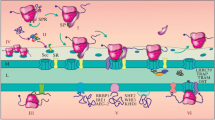Abstract
A large number of nucleus-encoded messenger RNAs (mRNAs) encoding proteins involved in oxidative phosphorylation have been found to be associated with mitochondria in vivo, indicating organelle-specific mRNA targeting. However, the identification of mitochondrion-bound mRNA (Mtb-RNA) has traditionally relied on cumbersome isolations of polysomes from a large number of input cells and is therefore biased in favour of mRNAs associated through nascent targeting peptides emerging from the polysome during cotranslational import of their encoded proteins, and tends to ignore sequence-directed mRNA targeting. We have, therefore, sought to identify and quantify Mtb-RNAs rapidly in small numbers of cells, independently of their polysomal status. We isolated Mtb-RNAs from tissue-cultured cells under different conditions and assayed them by endpoint or real-time polymerase chain reaction (RT-PCR). We observed that (i) different Mtb-RNAs are differentially affected by cycloheximide-induced polysome arrest, indicating possible artifacts of the use of this translation elongation inhibitor; (ii) several Mtb-RNAs have direct affinity for the mitochondrial surface in vitro, indicating the possibility of targeting through mRNA recognition by surface-bound RNA-binding proteins (RBP); and (iii) mRNA–mitochondrion interactions are stabilized by formaldehyde crosslinking. Our results reveal the importance of sequence-directed targeting of mRNAs to mitochondria.





Similar content being viewed by others
References
Banik M. and Adhya S. 2022 OXPHOS deficiency induces mitochondrial DNA synthesis through non-canonical AMPK-dependent mRNA compartmentalization. J. Biosci. 47, 67.
Grolleau A., Bowman J., Pradet-Balade B., Puravs E., Hanash S., Garcia-Sanz J. A. et al. 2002 Global and specific translational control by rapamycin in T cells uncovered by microarrays and proteomics. J. Biol. Chem. 277, 22175–22184.
Jan C. H., Williams C. C. and Weissman J. S. 2014 Principles of ER cotranslational translocation revealed by proximity-specific ribosome profiling. Science 346, 1257521.
Jung H., Gkogkas C. G., Sonenberg N. and Holt C. E. 2014 Remote control of gene function by local translation. Cell 157, 26–40.
Knight Z. A., Tan K., Birsoy K., Schmidt S., Garrison J. L., Wysocki R. W. et al. 2012 Molecular profiling of activated neurons by phosphorylated ribosome capture. Cell 151, 1126–1137.
Marc P., Margeot A., Devaux F., Blugeon C., Corral-Debrinski M. and Jacq C. 2002 Genome-wide analysis of mRNAs targeted to yeast mitochondria. EMBO Rep. 3, 159–164.
Matsumoto S., Uchiumi T., Saito T., Yagi M., Takazaki S., Kanki T. et al. 2012 Localization of mRNAs encoding human mitochondrial oxidative phosphorylation proteins. Mitochondrion 12, 391–398.
Saint-Georges Y., Garcia M., Delaveau T., Jourdren L., Crom L. S., Lemoine S. et al. 2008 Yeast mitochondrial biogenesis: A role for the PUF RNA-binding protein Puf3p in mRNA localization. PLoS One 3, e2293.
Santos D. A., Shi L., Tu B. P. and Weissman J. S. 2019 Cycloheximide can distort measurements of mRNA levels and translation efficiency. Nucleic Acids Res. 47, 4974–4985.
Williams C. C., Jan C. H. and Weissman J. S. 2014 Targeting and plasticity of mitochondrial proteins revealed by proximity-specific ribosome profiling. Science 346, 748–751.
Acknowledgements
This study was supported by CSIR Emeritus Scientist Scheme No. 21(0995)/16/EMR-II to S.A.
Author information
Authors and Affiliations
Corresponding author
Additional information
Ad-hoc editor: Purusharth Rajyaguru
Rights and permissions
About this article
Cite this article
Adhya, S., Banik, M. Many OX PHOS and replication factor mRNAs target mitochondria through specific binding to the organelle surface, independent of co-translational protein import. J Genet 102, 20 (2023). https://doi.org/10.1007/s12041-022-01414-6
Received:
Revised:
Accepted:
Published:
DOI: https://doi.org/10.1007/s12041-022-01414-6




